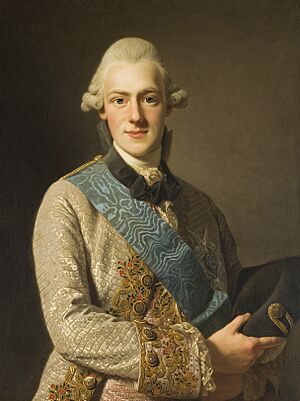Prince Frederick Adolf, Duke of Östergötland facts for kids
Quick facts for kids Prince Frederick Adolf |
|
|---|---|
| Duke of Östergötland | |

Portrait by Alexander Roslin, c. 1770
|
|
| Born | 18 July 1750 Drottningholm, Sweden |
| Died | 12 December 1803 (aged 53) Montpellier, France |
| Burial | Riddarholmen Church |
| House | Holstein-Gottorp |
| Father | Adolf Frederick of Sweden |
| Mother | Louisa Ulrika of Prussia |
Prince Frederick Adolf, Duke of Östergötland (Fredrik Adolf in Swedish), was born on July 18, 1750. He was a Swedish Prince, the youngest son of King Adolf Frederick of Sweden and Louisa Ulrika of Prussia. His mother, Louisa Ulrika, was the sister of Frederick the Great, who was the King of Prussia. Frederick Adolf was given the important title of Duke of Östergötland.
Contents
Early Life and Education
As a child, Frederick Adolf was taught by Ulrica Schönström. People said he was "the most beautiful Prince in Europe." He was also described as sensitive. He and his sister, Sophia Albertina, were very close. They were also their mother's favorite children.
During family disagreements, such as a time when there were questions about the Crown Prince's birth in 1778, Frederick and Sophia Albertina supported their mother against their brothers, Charles and Gustav. When he was young, Frederick Adolf often had poor health and a strong temper. His education was not as complete as it could have been.
Military Career
Frederick Adolf began his military career early. He became a colonel in 1762 and a general major in 1768. By 1774, he was a general lieutenant. He took command of the Västmanland regiment in 1775 and became a field marshal in 1792.
He played a small part in the Revolution of 1772. His brother, King Gustav III, asked him to help gather support in the areas of Södermanland and Östergötland.
During King Gustav III's Reign
Frederick Adolf was given the title Duke of Östergötland on September 8, 1772. He also received Tullgarn Palace as his home.
During a big family issue in 1778, his mother, Queen Dowager Louisa Ulrika, had doubts about the Crown Prince. It was Frederick who convinced his mother to meet King Gustav III before she died in 1782. This helped them make peace.
His sister-in-law, Hedwig Elizabeth Charlotte of Holstein-Gottorp, wrote about him. She said he was handsome with expressive eyes and a friendly personality. She noted he looked very good when he dressed up, but often dressed casually at home.
Frederick Adolf did not have many official duties beyond ceremonies. He spent a lot of money. King Gustav III reportedly did not think he was very smart. However, Frederick was an honorary member of the Swedish Royal Academy of Fine Arts. He sometimes showed real interest in the academy's work. He also cared about managing the Västmanland regiment. He enjoyed spending time at his home, Tullgarn. His money problems were severe, and in 1791, he was declared bankrupt. His finances were managed by others until 1802.
Frederick served in the Russo-Swedish War in Finland in 1788. During the Battle of Hogland, he wanted to send ships to help his brother, Duke Charles. This was not allowed. Frederick left the army in protest against Gustav III, whom he called a "tyrant." Because of this, he joined the group that opposed the king.
He was also involved in a plan by his sister-in-law to remove the king from power. This was called the 1789 Conspiracy. In the autumn of 1789, Hedvig Elisabeth Charlotte planned to replace Gustav III with her husband, Duke Charles. She worked with Prince Frederick Adolf and Gustaf Adolf Reuterholm. The idea was to make Charles lead the opposition. However, when the time came, Charles refused, and the plan stopped.
During King Gustav IV Adolf's Reign
In July 1793, Frederick Adolf was asked to lead the government for a short time. This was while the king and regent traveled in the southern parts of the country. However, not much was achieved during his time in charge. He was not given this responsibility again during a similar trip in 1794.
In 1800, Frederick Adolf left Sweden because of his health. He traveled to Germany and then to France. He passed away in Montpellier, France, in 1803.
Personal Life
Prince Frederick Adolf never married. His sister, Sophia Albertina, often performed the duties of a royal consort for him. He had several plans to marry, but none of them happened.
He had a long-term companion, Sophie Hagman, from 1778 to 1795. She was well-liked at court. He had a daughter named Sophia Frederica with her.

